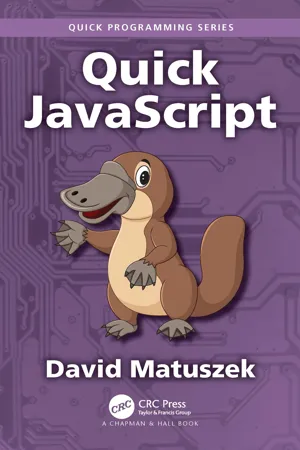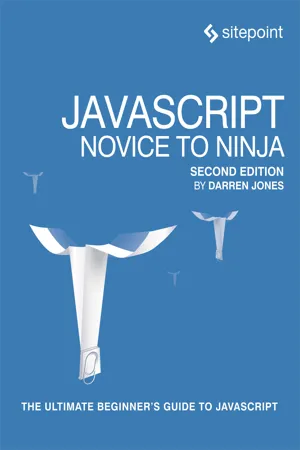Computer Science
Javascript Arrays
Javascript arrays are a data structure that allows you to store and manipulate a collection of values. They can hold any type of data, including strings, numbers, and objects, and can be accessed using index values. Arrays are commonly used in programming for tasks such as sorting, filtering, and iterating over data.
Written by Perlego with AI-assistance
Related key terms
7 Key excerpts on "Javascript Arrays"
- Loiane Groner(Author)
- 2018(Publication Date)
- Packt Publishing(Publisher)
Arrays
An array is the simplest memory data structure. For this reason, all programming languages have a built-in array datatype. JavaScript also supports arrays natively, even though its first version was released without array support. In this chapter, we will dive into the array data structure and its capabilities.An array stores values that are all of the same datatype sequentially . Although JavaScript allows us to create arrays with values from different datatypes, we will follow best practices and assume that we cannot do this (most languages do not have this capability).Passage contains an image
Why should we use arrays?
Let's consider that we need to store the average temperature of each month of the year for the city that we live in. We could use something similar to the following to store this information: const averageTempJan = 31.9; const averageTempFeb = 35.3; const averageTempMar = 42.4; const averageTempApr = 52; const averageTempMay = 60.8;However, this is not the best approach. If we store the temperature for only one year, we can manage 12 variables. However, what if we need to store the average temperature for more than one year? Fortunately, this is why arrays were created, and we can easily represent the same information mentioned earlier as follows:const averageTemp = []; averageTemp[0] = 31.9; averageTemp[1] = 35.3; averageTemp[2] = 42.4; averageTemp[3] = 52; averageTemp[4] = 60.8; We can also represent the averageTemp array graphically:Passage contains an image
Creating and initializing arrays
Declaring, creating, and initializing an array in JavaScript is really simple, as the following shows: let daysOfWeek = new Array(); // {1} daysOfWeek = new Array(7); // {2} daysOfWeek = new Array('Sunday', 'Monday', 'Tuesday', 'Wednesday', 'Thursday', 'Friday', 'Saturday'); // {3}We can simply declare and instantiate a new array using the keyword new (line {1}). Also, using the keyword new, we can create a new array specifying the length of the array (line {2}). A third option would be passing the array elements directly to its constructor (line {3}).- eBook - ePub
LPI Web Development Essentials Study Guide
Exam 030-100
- Audrey O'Shea(Author)
- 2023(Publication Date)
- Sybex(Publisher)
Chapter 14 JavaScript DataLINUX PROFESSIONAL INSTITUTE, WEB DEVELOPMENT ESSENTIALS EXAM 030‐100 OBJECTIVES COVERED IN THIS CHAPTER:-
034 JavaScript Programming
- 034.2 JavaScript Data Structures: The Candidate should be able to use variables in JavaScript code. This includes understanding values and data types. Furthermore, the candidate should understand assignment operators and type conversion and be aware of variable scope.
- Key Knowledge Areas:
- Define and use variables and constants
- Understand data types
- Understand type conversion/coercion
- Understand arrays and objects
- Awareness of the variable scope
- Files, terms, and utilities:
- =, +, ‐, *, /, %, ‐‐, ++, +=, ‐=, *=, /=
- var, let, const
- boolean, number, string, symbol
- array, object
- undefined, null, NaN
In the previous chapter, you learned the rules and format for writing JavaScript code and including it in your HTML pages. In this chapter, you'll learn about the types of data and how to work with variables and their values. We'll also look at the math operators, some shortcuts, and how to create and use arrays and objects to save time and avoid human error. There's a lot to cover, so let's get started!Variables, Constants, and Scope
One of the first things I teach my information technology students is that the four main jobs of a computer system are input, output, processing, and storage. It's what programming and computer systems are all about. High‐level languages like JavaScript make it easier to tell computers how to accept your input, process it, and create output.You start with the data that you want to manipulate in some way. Maybe it's sales receipts for a business, actuary tables used to figure out the cost of someone's insurance, or an ingredient list for a recipe that you'll later make in a larger batch. You must input data into a program before the other steps can take place.Data is gathered and stored in variables and constants. Later in this chapter you'll learn about advanced data structures used to organize data that's been input. In JavaScript and most other programs, variables and constants are declared differently and have different restrictions on their use. Variables and constants have two similarities—the variable or constant must start with an underscore or a letter, and their values are assigned in name= - eBook - ePub
- David Matuszek(Author)
- 2023(Publication Date)
- Chapman and Hall/CRC(Publisher)
undefined .2.2.3 Built-In Object Types
JavaScript comes with a number of built-in, or predefined, object types. Among these are arrays, sets, maps, dates, and regular expressions.2.2.4 Arrays
An array is an ordered collection of values. An array literal can be defined by enclosing comma-separated values in square brackets:let ary = ["cat", "dog", "mouse"];Commas can be used either between values or after values, so the above assignment is exactly equivalent to:let ary = ["cat", "dog", "mouse", ];The last comma is sometimes called a trailing comma.Array indexing is zero-based; the first element of the above array is ary[0] and the last is ary[ary.length – 1] .Arrays of higher dimension can be created simply by nesting array literals: let ary2d = [[11, 12], [21, 22]];After the above assignment, ary2d[1] is [21, 22] and ary2d[1][0] is 21 .A less-often used form is Array( values) :let ary = new Array("cat", "dog", "mouse");This form is not generally recommended. One odd feature of it is that if the argument is a single numeric value, Array( n) , the result is a sparse array of n locations, not an array containing the single value n.In a sparse array, no storage is allocated for the elements of the array until they have been assigned values; unassigned locations will appear to have the value undefined . A sparse array can be arbitrarily large (only the actual values in it contribute to its size), but it is slower to work with.The length property of an array is always one more than the largest index. Since an array may be sparse, length - eBook - ePub
- Laurence Lars Svekis, Maaike van Putten, Codestars By Rob Percival(Authors)
- 2021(Publication Date)
- Packt Publishing(Publisher)
3
JavaScript Multiple Values
The basic data types have been dealt with in the previous chapter. Now it's time to look at a slightly more complicated topic: arrays and objects. In the previous chapter, you saw variables that held just a single value. To allow for more complex programming, objects and arrays can contain multiple values.You can look at objects as a collection of properties and methods. Properties can be thought of as variables. They can be simple data structures such as numbers and strings, but also other objects. Methods perform actions; they contain a certain number of lines of code that will be executed when the method gets called. We'll explain methods in more detail later in this book and focus on properties for now. An example of an object can be a real-life object, for example, a dog. It has properties, such as name, weight, color, and breed.We will also discuss arrays. An array is a type of object, which allows you to store multiple values. They are a bit like lists. So, you could have an array of items to buy at the grocery store, which might contain the following values: apples, eggs, and bread. This list would take the form of a single variable, holding multiple values.Along the way, we will cover the following topics:- Arrays and their properties
- Array methods
- Multidimensional arrays
- Objects in JavaScript
- Working with objects and arrays
Note: exercise, project and self-check quiz answers can be found in the Appendix .Arrays and their properties
Arrays are lists of values. These values can be of all data types and one array can even contain different data types. It is often very useful to store multiple values inside one variable; for example, a list of students, groceries, or test scores. Once you start writing scripts, you'll find yourself needing to write arrays very often; for example, when you want to keep track of all the user input, or when you want to have a list of options to present to the user. - eBook - ePub
- Jeff Szuhay(Author)
- 2022(Publication Date)
- Packt Publishing(Publisher)
Chapter 11 : Working with ArraysWe have already seen how a structure is a grouping of one or more components that can each be of different data types. Often, we need a grouping that consists of the same type; this is called an array . An array is a collection of multiple occurrences of the same data type grouped together under a single name. Each element of the array is accessed via its base name and an offset of that base. Arrays have many uses, from organizing homogenous data types to providing the basis for strings, or arrays of characters.Before we can learn about some of the wide uses of arrays, we need to explore the basics of declaring and manipulating arrays. The following topics will be covered in this chapter:- Declaring an array of values
- Initializing an array in several ways
- Understanding variable-length arrays
- Accessing each element of an array
- Understanding zero-based array indexing
- Assigning and manipulating elements of an array
- Using looping statements to access all elements of an array
- Using array references as function parameters
Technical requirements
Continue to use the tools chosen from the Technical requirements section of Chapter 1 , Running Hello, World! .The source code for this chapter can be found at https://github.com/PacktPublishing/Learn-C-Programming-Second-Edition/tree/main/Chapter11 .Declaring and initializing arrays
An array is a collection of two or more values, all of which have the same type and share a single common base name. It makes no sense to have an array of just one value; that would simply be a variable. An array definition has the following syntax: dataType arrayIdentifier[ numberOfElements ]; Here, dataType is any intrinsic or custom type, arrayIdentifier is the base name of the array, and numberOfElements specifies how many values of dataType are in the array. numberOfElements , for whatever type and values are given, is a literal constant or expression that will be converted to an integer. Most commonly, numberOfElements is an integer constant expression. An array whose size is defined by a constant expression we call a constant-length array - eBook - ePub
C Programming
Learn to Code
- Sisir Kumar Jena(Author)
- 2021(Publication Date)
- Chapman and Hall/CRC(Publisher)
10 Arrays and StringsDOI: 10.1201/9781003188254-1010.1 Introduction
Many times, we come across a situation where we use a set of data rather than a single datum. For example, assume that you are an instructor and you teach C programming. You want to store the marks of your students and later perform different types of operations on them, such as finding the top performer or knowing how many students secure less than 50 marks. In that case usage of a single variable is not enough: you need multiple variables to store the data of your students. Again, if you use many variables in your program then remembering those variable names will become difficult. So, the solution is the array – a concept provided by C that handles large numbers of items simultaneously.In our day-to-day life we also came across situations where we need to group items and keep them in a sequential manner for easy access. For example, Figure 10.1 shows a toy train built to store painting items such as watercolors, sketch pens, brushes, pencils, and oil pastels. We name this train the Painter’s Train. We number the boxes from 1 to 5 and store many items in them. The concept of arranging similar data and calling them using a common name is sometimes known as an array of items.An array is a series of elements of the same type, placed in contiguous memory locations that can be individually referenced by adding an index number to each location. Other definitions are:Figure 10.1 Introducing the concept of an array.- An array is a single programming variable with multiple "compartments." Each compartment can hold a value.
- A collection of data items, all of the same type, in which the position of each item is uniquely designated by a discrete type.
- eBook - ePub
- Darren Jones(Author)
- 2017(Publication Date)
- SitePoint(Publisher)
Chapter 3: Arrays, Logic, and Loops
In this chapter we’ll look at some of the data structures used in JavaScript to store lists of values. These are called arrays, sets, and maps. We’ll also look at logical statements that allow us to control the flow of a program, as well as loops that allow us to repeat blocks of code over and over again.This chapter will cover the following topics:- Array literals
- Adding and removing values from arrays
- Array methods
- Sets
- Maps
- if and else statements
- switch statements
- while loops
- do … while loops
- for loops
- Iterating over a collection
- Project ― we'll use arrays, loops and logic to ask multiple questions in our quiz
Arrays
An array is an ordered list of values. To create an array literal, simply write a pair of square brackets: const myArray = []; << [] You can also use an array constructor function: const myArray = new Array(); << []Both of these produce an empty array object, but it’s preferable to stick to using array literals because of a variety of reasons ... and they require less typing!Arrays are not primitive values but a special built-in object, as we can see when we use the typeof operator:typeof [] << 'object'You can read more about creating and manipulating arrays in this article .Initializing an Array
We can create an empty array literal called heroes with the following code:const heroes = [];We can find out the value of element 0 in the heroes array using the following code:heroes[0] << undefinedTo access a specific value in an array, we write its position in the array in square brackets (this is known as its index). If an element in an array is empty, undefined is returned.Adding Values to Arrays
To place the string 'Superman' inside the first element of our heroes array, we can assign it to element 0 , like so:heroes[0] = 'Superman';Each item in an array can be treated like a variable. You can change the value using the assignment operator = . For example, we can change the value of the first item in the heroes
Learn about this page
Index pages curate the most relevant extracts from our library of academic textbooks. They’ve been created using an in-house natural language model (NLM), each adding context and meaning to key research topics.






